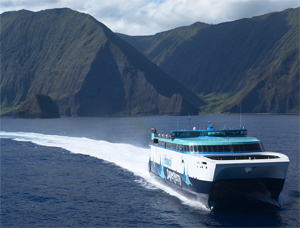The U.S. Navy has added two ferries from the defunct Hawaii inter-island service to its heavy sealift fleet.
The Navy paid $35 million to the U.S. Maritime Administration (MarAd) for Alakai and Huakai, formerly owned by Hawaii Superferry Inc., and will likely add them to its growing fleet of high-speed sealift vessels available for fast response with the military or disaster relief. The deal was completed in January.
MarAd had supported the original $178 million cost of the ferries with a loan guarantee of almost $140 million. When Hawaii Superferry went bankrupt, the federal government became responsible for repaying the balance of about $135 million.
At the December 2010 foreclosure sale, MarAd gained title to the ships in return for a $50 million reduction in the amount it owed the lenders in loan guarantees. With the amount the Navy paid to MarAd, the default payment on the loan guarantee is now about $84 million, according to Kimberly Riddle, a MarAd spokesperson.
As of January 2012, the vessels remained at Lambert’s Point Dock in Norfolk, Va., awaiting refit for their new role with the Navy, according to John Keever, president of Seaward Services Inc., a subsidiary of HMS Global Maritime, the company that operated the ferries in Hawaii. HMS also operates other similar high-speed vessels for the Navy.
Huakai will replace the aging HSV WestPac Express vessel operated for the Marines in Okinawa, according to Lt. Cmdr. Alana Garas, a Navy spokesperson. Plans are not finalized for Alakai, but Keever thinks it will most likely serve somewhere in the Pacific as well, possibly in Guam or with the Marine contingent scheduled to deploy to Australia.
To transition from ferry operations to military service, the ferries will undergo refitting to accommodate crews, enhanced anchoring capability and beefed up vehicle ramps. Keever expects the work to take four to six months at a cost of $5 million to $8 million. Refit work will include a galley, berths and increased water and sanitation capacity for the 15-person crew.
Keever expects each vessel to require a 30-person, unlimited-tonnage-licensed civilian crew for continuous operations.
The vessels were built with Title XI loan guarantees from MarAd to provide inter-island ferry service in Hawaii. Alakai operated from December 2007 to March 2009 primarily in service between Oahu and Maui. The other vessel, Huakai, was not completed before legal battles and environmental issues halted the ferry service.
Protesters blocked Alakai’s second visit to Nawiliwili Harbor on Kauai, stranding passengers for nine hours before the U.S. Coast Guard cleared a path to the dock. In March 2009 the Hawaii Supreme Court ruled that the law allowing the Superferry to operate before the completion of an environmental study was unconstitutional. Two months later the company filed for Chapter 11 bankruptcy protection.
In addition to the MarAd loans, the demise of Hawaii Superferry left debts of $22.9 million to shipbuilder Austal USA, $40 million to the state of Hawaii for harbor improvements and $51.7 million to Guggenheim Funding LLC. In addition, J.F. Lehman & Co., the controlling private investor in the project founded by former Navy Secretary John F. Lehman, will likely lose the $85.2 million it paid for preferred stock in the company.
Austal USA built the two aluminum-hulled catamaran ro-ro ferries at its shipyard in Mobile, Ala. The 349-foot Alakai and 366-foot Huakai are powered by four 11,000-hp MTU diesels and can cruise at 40 knots. The ships have a capacity of 866 passengers and crew and 282 autos, or 25,000 square feet of cargo.
The vessels were designed to be environmentally friendly, incorporating technologies such as non-toxic bottom paint, zero wastewater discharge and clean diesel engines.
In 2010, Huakai was tapped for earthquake relief missions to Haiti, where the vessel design proved its utility. “They’re self-contained and all they need is someplace to set the ramps down,” Keever said. “They’ve proven the concept with the military and that’s why they’re starting to expand the number of these types of vessels.”

